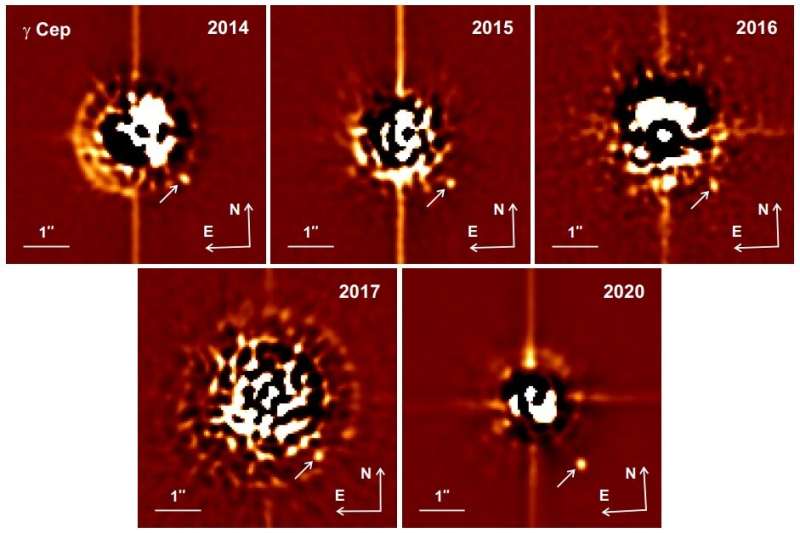March 15, 2022 report
Observations explore the properties of binary system Gamma Cephei

Astronomers from Jena Observatory in Germany and elsewhere have performed follow-up observations of a nearby binary star system known as Gamma Cephei. Results of the observational campaign, published March 8 on arXiv.org, deliver essential information about the properties of this system.
Gamma Cephei is a binary star system located some 45 light years away in the constellation of Cepheus. The primary star Gamma Cephei A is a subgiant of spectral type K1III-IV CN1—the third brightest in this constellation. The star is around five times larger than the sun and its mass is estimated to be 1.41 solar masses. In 1988, an exoplanet orbiting this star was discovered that received designation Gamma Cephei Ab and was later dubbed Tadmor. The planet has a mass of about 1.7 Jupiter masses and orbits its host every 903 days at a distance of 2.05 AU from it.
The secondary star Gamma Cephei B is probably a red dwarf of class M4 and its mass is estimated to be approximately 0.4 solar masses. The companion is separated from the primary star by about 20.18 AU. The orbital period of the system was measured to be about 67.5 years.
A group of astronomers led by Jena Observatory's Markus Mugrauer has observed the Gamma Cephei system as part of their multiplicity study of exoplanet host stars. They conducted imaging and spectroscopic observations of this binary using the 2.2 m telescope at the Calar Alto Observatory in Spain and the 0.9 m telescope of the University Observatory Jena.
"We present follow-up imaging and spectroscopic observations of the exoplanet host star Gamma Cephei A, and of its low-mass stellar companion Gamma Cephei B. We used the lucky-imager AstraLux at the Calar Alto observatory to follow the orbital motion of the companion around its primary, whose radial velocity was determined with spectra of the star, taken with the Échelle spectrograph FLECHAS at the University Observatory Jena," the researchers wrote in the paper.
Results from AstraLux and FLECHAS observations combined with additional observational data, compiled from the literature, allowed Mugrauer's team to determine a new orbital solution of the Gamma Cephei system. The astronomers used the determined Keplerian orbital elements to derive the system parameters.
The study found that the orbit of Gamma Cephei has an eccentricity at a level of 0.41 and the orbital period of the system is 66.84 years, therefore slightly shorter than previously thought. The separation of the companion from the primary star was measured to be 19.56 AU, hence smaller than suggested by other studies.
The masses of Gamma Cephei A and B were found to be about 1.29 and 0.38 solar masses, respectively. The researchers noted that the obtained mass of the companion is in good agreement with that derived by them from the near-infrared photometry available in the literature.
Based on their new orbital solution for Gamma Cephei, the authors of the paper suppose that the companion star will reach its apocenter at the end of 2024 and its angular separation to the primary will increase until early 2029, when it will exhibit an angular separation of about 1.97 arcseconds. They predict that Gamma Cephei B will be separated from the primary star by more than 1.4 arcseconds until 2043.
More information: M. Mugrauer et al, Follow-up observations of the binary system Gamma Cephei. arXiv:2203.04128v1 [astro-ph.SR], arxiv.org/abs/2203.04128
© 2022 Science X Network



















